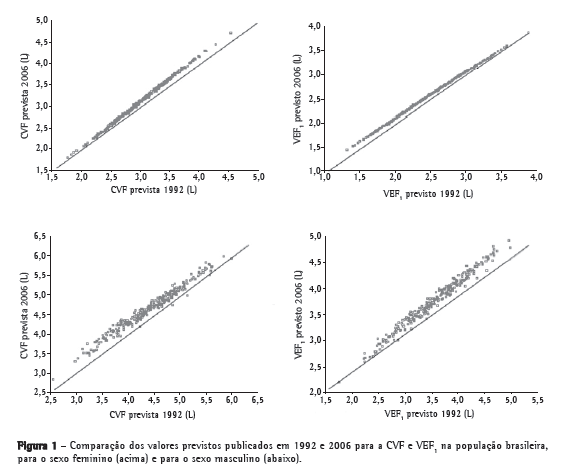

Carlos Alberto de Castro Pereira, Taeko Sato, Sílvia Carla Rodrigues
ABSTRACT
Objective: To describe spirometric reference equations for healthy Brazilian adults who have never smoked and to compare the predicted values with those derived in 1992. Methods: Reference equations for spirometry were derived in 270 men and 373 women living in eight cities in Brazil. Ages ranged from 20 to 85 years in women and from 26 to 86 years in men. Spirometry examinations followed the recommendations of the Brazilian Thoracic Society. Lower limits were derived by the analysis of the fifth percentiles of the residuals. Results: Forced vital capacity (FVC), forced expiratory volume in one second (FEV1), FEV1/FVC and FEV1/forced expiratory volume in six seconds (FEV6) were best fitted by linear regression. Flows were best fitted using log equations. For both genders, greater height resulted in lower values for FEV1/FVC, FEV1/FEV6 and flow/FVC ratios. The reference values for FEV1 and FVC in the present study were higher than those derived for Brazilian adults in 1992. Conclusion: New predicted values for forced spirometry were obtained in a sample of white Brazilians. The values are greater than those obtained in 1992, probably due to technical factors.
Keywords: Spirometry; Reference Values; Respiratory Function Tests.
RESUMO
Objetivo: Descrever novas equações de referência para a espirometria em adultos brasileiros saudáveis que nunca fumaram, e comparar os valores previstos atuais com os valores derivados em 1992. Métodos: Equações e limites de referência foram derivados em 270 homens e 373 mulheres, habitantes de oito cidades brasileiras, por espirômetro. A idade variou de 20 a 85 anos nas mulheres e 26 a 86 anos nos homens. Os exames seguiram as normas recomendadas pela Sociedade Brasileira de Pneumologia e Tisiologia. Os limites inferiores foram derivados pela análise do 5º percentil dos resíduos. Resultados: Os valores previstos para capacidade vital forçada (CVF), volume expiratório forçado no primeiro segundo (VEF1) e para as relações VEF1/CVF e VEF1/volume expiratório forçado nos primeiros seis segundos (VEF6) se ajustaram melhor em regressões lineares. Os fluxos ajustaram-se melhor em equações logarítmicas. Em ambos os sexos, maiores estaturas resultaram em menores valores para as relações VEF1/CVF, VEF1/VEF6 e fluxos/CVF. Os valores de referência do VEF1 e da CVF, no presente estudo, foram maiores do que aqueles derivados para adultos brasileiros em 1992. Conclusão: Novos valores previstos para a espirometria forçada foram obtidos em uma amostra da população brasileira de raça branca. Os valores são maiores do que os obtidos em 1992, provavelmente em decorrência de fatores técnicos.
Palavras-chave: Espirometria; Valores de Referência; Testes de Função Respiratória.
Introdução



